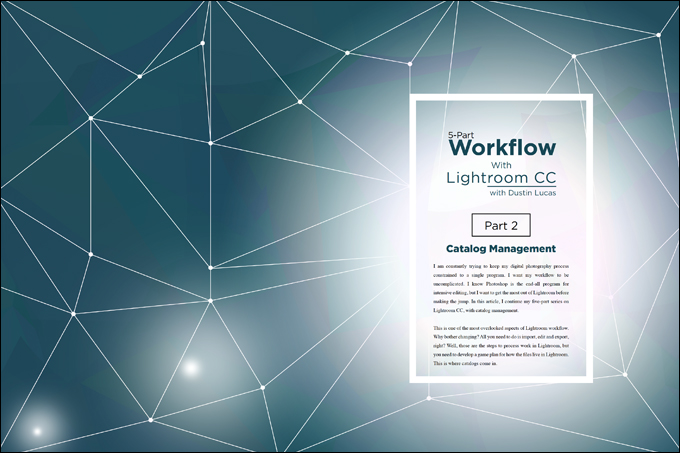5-Part Workflow With Lightroom CC Part 2 with Dustin Lucas
Catalog Management
I am constantly trying to keep my digital photography process constrained to a single program. I want my workflow to be uncomplicated. I know Photoshop is the end-all program for intensive editing, but I want to get the most out of Lightroom before making the jump. In this article, I continue my five-part series on Lightroom CC, with catalog management.
This is one of the most overlooked aspects of Lightroom workflow. Why bother changing? All you need to do is import, edit and export, right? Well, those are the steps to process work in Lightroom, but you need to develop a game plan for how the files live in Lightroom. This is where catalogs come in.
Create a Catalog
Creating a catalog is simple: Just open Lightroom, navigate to the menu bar and click File > New Catalog. This is where you can decide where to store the catalog and how to manage your future jobs. You can create a client/job catalog or a master catalog. Now let’s organize your workflow.
If you like to store the catalogs with the Raw files on your working drive, make a new catalog per job. This allows you to store everything together for convenient access. With convenience comes the cost of performance when working off an external hard drive. Keep the catalogs on a local drive so there isn’t lag time while working in them. On the down side, you don’t have quick access to all of your files when working this way. You have to dig up another catalog to view another job. Put them all into one catalog.
Master catalogs are a great strategy for organizing all of your work. As a best practice, make a new one per year. This lets you jump from job to job so much faster. Remember, as you import more work into a single catalog, it becomes increasingly slower and unsafe to work from. This requires backing up catalogs, which I will cover later.
Building Previews
Lightroom allows you to view and process your image files by rendering previews. There are five types of previews: Minimal, Embedded & Sidecar, Standard, 1:1 and Smart. The process for building these previews starts at import. Minimal is preferred for import performance. Embedded & Sidecar is slightly larger and generates the image file by accessing the JPEG preview.
A secondary option is to build previews after import, which is highly advised for Standard, 1:1 and Smart. To access these options, go to the Library module, navigate to the menu bar and click Library > Previews.
Standard previews are best for culling and most editing tasks. These previews automatically render once an effect is applied in the Develop module. You will notice a new file appear in the folder where the catalog is saved. It is important to keep these together. To choose the size of these, go to Catalog Settings in the menu bar, and select the File Handling tab. Pixel dimensions correlate to your screen size. Choose the appropriate size based on the width of your screen. For example, if computer resolution is 1920 x 1200, I would set my standard preview to 2048 pixels. For quality, I would choose Low to gain a little performance.
More advanced editing and full capability to zoom in at 100% require the building of 1:1 previews. These take significantly longer to create, so walk away from your computer while they process. You can build these at import, which makes processing files increasingly faster, but this slows down importing. It’s a give-and-take. Build them a few hours before you edit.
Lightroom 5 and later versions introduced Smart Previews. These are a different type of preview altogether because they do not require the image files to be linked to a catalog. What do you need to edit with, then? Like 1:1 previews, you have to actively build them. You can also do this at import by going to the File Handling section and clicking on Build Smart Previews. This is a time-consuming process and unnecessary for all your captured files. Build these once you finish your selection process. However, if you are using Lightroom to select, this is a performance-enhancing option.
These Smart Preview files are a fraction of the total size of your Raw files. In this catalog, I have over 5,000 images totaling 107GB of data. Smart Previews for these images would be a little more than 4GB total. That is an insane amount of space saved. Not only do you gain space and performance, you can fully edit the images within Lightroom. This takes us to exporting catalogs and using Smart Previews.
Export as Catalog
This option is great for outsourcing your work and lowering the amount of data you have to upload. Once you select the specific images, go to File > Export as Catalog. A dialog box appears asking for a location to save to as well as Export Negative Files, Build/Include Smart Previews and Include Available Previews. Export Negative Files makes copies of the Raw files and puts them in a folder. This is a huge time saver versus individually selecting files in Finder. Exporting with Smart Previews packages them with the catalog in a new location. With this catalog opened, you no longer need access to the Raw files. Including available previews in the export is useful only if you are linked to the original files. These built previews save time when viewing and editing the full-resolution Raw files.
Optimizing Your Catalog
Whether you are working in a single job or master catalog, you need to keep the catalog at optimum performance and stability. Your first step is the easiest one: Click on File > Optimize Catalog. From here, it’s important to store your catalog on your local hard drive. Make sure you exceeded the minimum hardware requirements for Lightroom.
In Lightroom Preferences, choose the File Handling tab and look at Camera Raw Cache Settings. I set mine to the total file size of my entire job, which is 100GB. Moving to the Performance tab brings in the help of the GPU or graphics card. For most users, it helps to uncheck the option Use Graphics Processor. This option works well on the 5K iMacs, but most users should leave it off. For some reason, this comes as a default setting.
By accessing Catalog Settings, you can increase performance as well. Click on the metadata tab and make sure you uncheck Automatically Write Changes Into XMP. This process runs every time you make a change to your files. Manually save metadata afterward. Previously, I mentioned how to lower the quality of Standard Previews, which helps to increase rendering time. In the General tab, choose when to prompt the Backup when closing a catalog, which brings us to the next topic.
Back Up Catalog
This is a very important step in using catalogs. You need to back up your catalog on a separate disk from where your original is saved. To change this location, close a catalog and click Choose. I use a cloud storage platform like Dropbox or OneDrive to store this file. That way, I have access to it on any computer that’s connected to the Internet.
Optimize the Catalog is another option in this window. This becomes important as your catalog increases in size. This can cause corruption as you repeatedly open and close the catalog.
Conclusion
I use Lightroom for the majority of my post-processing, so optimizing the catalog is a must for me. Managing catalogs is as important as managing files. Once you choose what type of catalog you want to make, import the files and render previews. It’s that simple. These first two articles have shown the essential steps in maintaining a solid workflow for your business. Tune in next month for the third part, in which I’ll look at processing files.




